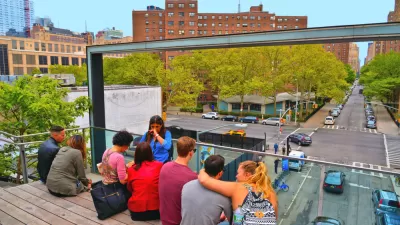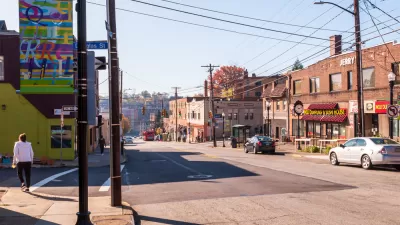Once upon a time, there was a city called City. And everyone living in City voted in the same elections and paid taxes to the same government. And then 5 percent of the people decided that they wanted to live in an new neighborhood that was opened up for development by the highways. And they called it Richburb, because they were, if not rich, at least a little richer than many of the people in the city (since even if there wasn’t zoning to keep the poor out, new housing usually costs more than old housing anyhow).
Once upon a time, there was a city called City. And everyone living in City voted in the same elections and paid taxes to the same government.
And then 5 percent of the people decided that they wanted to live in an new neighborhood that was opened up for development by the highways. And they called it Richburb, because they were, if not rich, at least a little richer than many of the people in the city (since even if there wasn't zoning to keep the poor out, new housing usually costs more than old housing anyhow).
Because there weren't any poor people in Richburb, Richburb had a stronger tax base than the city, which meant it could provide more and tax less. And for the same reason, Richburb had more appealing schools; the Richburb teachers could focus on the average and above-average students, rather than having to focus on students who were slower (and sometimes less disciplined) because their parents were less educated.
So Richburb was on balance a better deal for a lot of people than was City: just by being newer and richer, it had lower taxes, better services and better schools.
So because Richburb was a better deal than the city, another 5 percent of the people left the City for Richburb. These 5 percent weren't that wild about leaving City, but what could they do? Richburb was just a better deal: better taxes, better schools, better services.
With 10 percent of its people gone, City began to suffer. Its tax base was eroded, so it had to raise taxes. And the neighborhoods vacated by the people who moved to Richburb were filled by people who were a little poorer and a little less well-behaved, thus making them less desirable neighborhoods. And when those people left poorer parts of town, their houses just stood vacant, totally ruining the poorer side of town. So crime and disorder multiplied.
As a result, another 10 percent of the people left City for Richburb. They wanted to stay in their old neighborhoods, but what could they do? Their taxes were going up and their neighborhoods were becoming unsafe.
And with 20 percent of its people gone, City suffered even more. After all that migration out of City, even the best part of town was a few blocks from rough neighborhoods instead of a few miles as it had been a decade or two earlier. And because the residents of the good part of town were so close to bad neighborhoods, their children were in the same school attendance zone as the children of the bad neighborhoods- which, for reasons discussed above, made those schools less appealing.
So another 10 percent left the City for Richburb. They wanted to stay in their old, once-fancy neighborhoods, but what could they do? Their neighborhoods were becoming less safe, and their schools were deteriorating too.
And because so many people had moved to Richburb, jobs started to follow the people - which meant that some people would have shorter commutes if they lived in Richburb. They wanted to stay in their old neighborhoods, but what could they do? Their taxes kept going up, and their neighborhoods were deteriorating, and their commutes kept getting longer and longer. And because a lot of the Richburb jobs weren't transit-accessible, transit accesibility, City's biggest advantage, didn't mean as much as it used to.
And so after a few decades, City had lost half its population, and no one but a few hipsters and a lot of poor people lived there (and more recently, a few yuppies colonizing its glittering, redeveloped downtown).
Then another highway opened up a new suburb called Richburb-2 for development. And a few of the better-off people in Richburb moved to Richburb-2, and were replaced by some people trying to get out of City's ghettoes. And City's cycle of decline started to happen all over again in Richburb. The revolution of sprawl was starting to devour its own children.
So half a century from the first highway into Richburb, City had become a pretty poor place, and Richburb was following it into the dustbin of history. All because a long time ago, 5 percent of the people wanted to move. And of course, the local paper said that all of this must have happened because everyone wanted to move to the suburbs.

Maui's Vacation Rental Debate Turns Ugly
Verbal attacks, misinformation campaigns and fistfights plague a high-stakes debate to convert thousands of vacation rentals into long-term housing.

Planetizen Federal Action Tracker
A weekly monitor of how Trump’s orders and actions are impacting planners and planning in America.

San Francisco Suspends Traffic Calming Amidst Record Deaths
Citing “a challenging fiscal landscape,” the city will cease the program on the heels of 42 traffic deaths, including 24 pedestrians.

Defunct Pittsburgh Power Plant to Become Residential Tower
A decommissioned steam heat plant will be redeveloped into almost 100 affordable housing units.

Trump Prompts Restructuring of Transportation Research Board in “Unprecedented Overreach”
The TRB has eliminated more than half of its committees including those focused on climate, equity, and cities.

Amtrak Rolls Out New Orleans to Alabama “Mardi Gras” Train
The new service will operate morning and evening departures between Mobile and New Orleans.
Urban Design for Planners 1: Software Tools
This six-course series explores essential urban design concepts using open source software and equips planners with the tools they need to participate fully in the urban design process.
Planning for Universal Design
Learn the tools for implementing Universal Design in planning regulations.
Heyer Gruel & Associates PA
JM Goldson LLC
Custer County Colorado
City of Camden Redevelopment Agency
City of Astoria
Transportation Research & Education Center (TREC) at Portland State University
Jefferson Parish Government
Camden Redevelopment Agency
City of Claremont






























